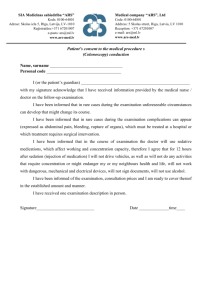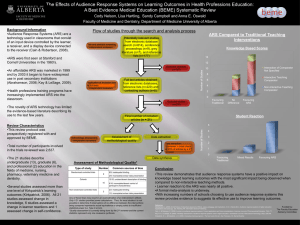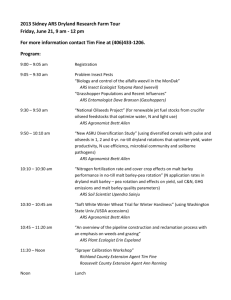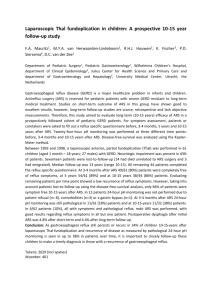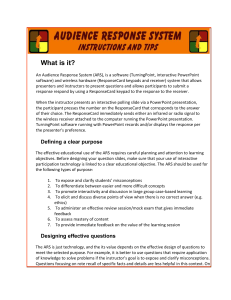Project
advertisement
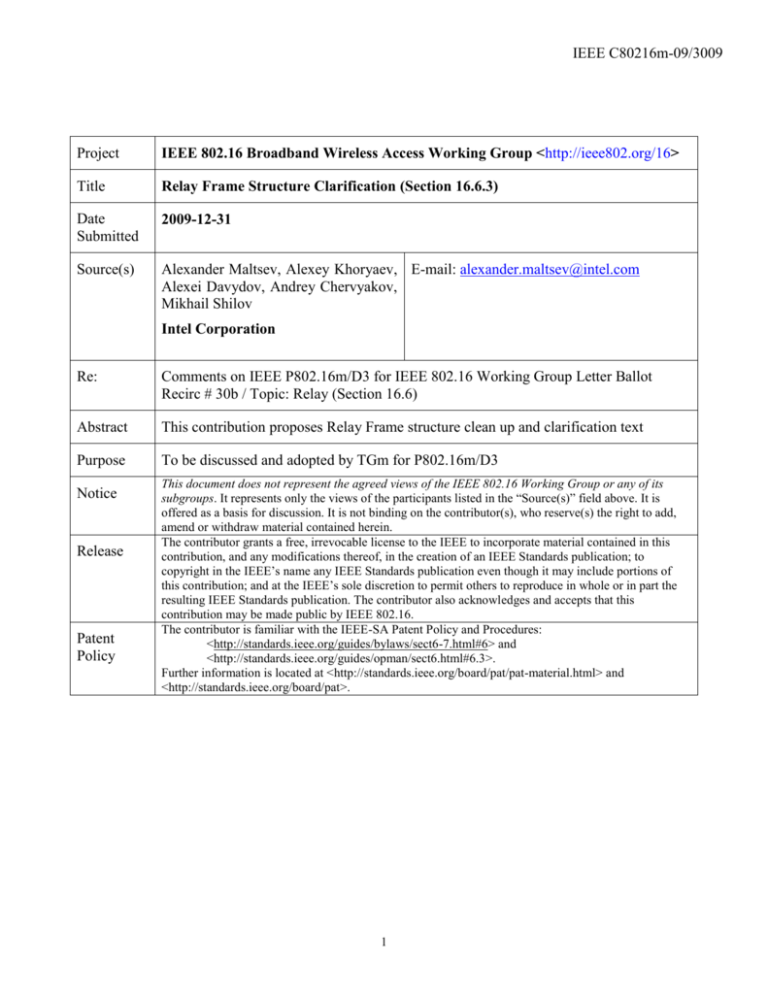
IEEE C80216m-09/3009 Project IEEE 802.16 Broadband Wireless Access Working Group <http://ieee802.org/16> Title Relay Frame Structure Clarification (Section 16.6.3) Date Submitted 2009-12-31 Source(s) Alexander Maltsev, Alexey Khoryaev, E-mail: alexander.maltsev@intel.com Alexei Davydov, Andrey Chervyakov, Mikhail Shilov Intel Corporation Re: Comments on IEEE P802.16m/D3 for IEEE 802.16 Working Group Letter Ballot Recirc # 30b / Topic: Relay (Section 16.6) Abstract This contribution proposes Relay Frame structure clean up and clarification text Purpose To be discussed and adopted by TGm for P802.16m/D3 Notice Release Patent Policy This document does not represent the agreed views of the IEEE 802.16 Working Group or any of its subgroups. It represents only the views of the participants listed in the “Source(s)” field above. It is offered as a basis for discussion. It is not binding on the contributor(s), who reserve(s) the right to add, amend or withdraw material contained herein. The contributor grants a free, irrevocable license to the IEEE to incorporate material contained in this contribution, and any modifications thereof, in the creation of an IEEE Standards publication; to copyright in the IEEE’s name any IEEE Standards publication even though it may include portions of this contribution; and at the IEEE’s sole discretion to permit others to reproduce in whole or in part the resulting IEEE Standards publication. The contributor also acknowledges and accepts that this contribution may be made public by IEEE 802.16. The contributor is familiar with the IEEE-SA Patent Policy and Procedures: <http://standards.ieee.org/guides/bylaws/sect6-7.html#6> and <http://standards.ieee.org/guides/opman/sect6.html#6.3>. Further information is located at <http://standards.ieee.org/board/pat/pat-material.html> and <http://standards.ieee.org/board/pat>. 1 IEEE C80216m-09/3009 Relay Frame Structure Clarification Alexander Maltsev, Alexey Khoryaev, Alexei Davydov Andrey Chervyakov, Mikhail Shilov Intel Corporation 1. Introduction This contribution mainly proposes editorial changes and a number of clarifications to the current amendment text describing frame structure supporting ARS and to be included in the 802.16m amendment draft [1]. The proposed text is developed so that it is compliant to the 802.16m SRD [2] and the 802.16m SDD [3], and it follows the style and format guidelines in [4]. The following changes are proposed in this contribution: References to the control messages for transmission of Relay zone configuration information (16m Access and 16m Relay zone configuration) for ARS and AMS stations are specified. The definitions of R-TTI and R-RTI transition intervals are clarified. The current amendment text has several contradictions on the position of these transition intervals. This contribution proposes to define the position of transition intervals for TDD and FDD modes. The examples of TDD and FDD Relay frame structure figures have a number of typos on the duration of AAI subframes. In this contribution new corrected figures are proposed. 2. References [1] IEEE P802.16m/D3, “Part 16: Air Interface for Fixed and Mobile Broadband Wireless Access Systems – DRAFT Amendment to IEEE Standard for Local and metropolitan area networks” [2] IEEE 802.16m-07/002r8, “802.16m System Requirements” [3] IEEE 802.16m-08/003r9, “The Draft IEEE 802.16m System Description Document” [4] IEEE 802.16m-08/043, “Style guide for writing the IEEE 802.16m amendment” 2 IEEE C80216m-09/3009 3. Text proposal for inclusion in the P802.16m/D3 Instruction to editor: Black text: existing D3 text Red and strike out text: for deletion Blue and underline text: for addition ============================= Start of the text #1============================== [Note to Editor – Modify the text in section 16.6.3.1 Basic frame structure supporting ARS in page 628 as follows] 16.6.3.1 Basic frame structure supporting ARS The advanced air interface supports two hop data transmission between an ABS and an AMS using an intermediate ARS. Figure 581 shows an example of the basic frame structure for system supporting ARSs. When an ARS is deployed it shall use the same OFDMA signal parameters (defined in Table 766) as its serving ABS. The ABS and ARS superframes shall be time aligned and shall consist of the same number of frames and AAI subframes. Every ARS superframe shall contain a superframe header (SFH). The SFH transmitted by the ARS shall have the same location and format as the SFH transmitted by the ABS. The ARS preambles (SA-Preamble and PA-Preamble) shall be transmitted synchronously with superordinate ABS preambles. When ARSs are supported the ABS frame is divided on 16m Access zone and 16m Relay zone. The 16m Access zone position precedes the 16m Relay zone position inside the frame. The duration of the 16m Access zone and 16m Relay zone may be different in DL and UL directions. The zone configuration of 16m Access zone and 16m Relay zone is informed to the ARS by the ABS in RS_config-CMD message. The ABS frame 16m Access zone shall consist of 16m DL Access zone and 16m UL Access zone, and 16m Relay zone shall consist of 16m DL Relay zone and 16m UL Relay zone. The ABS frame 16m Access zone shall be used for communication with AMSs only. The ABS frame 16m Relay zone shall be used for communication with ARSs and may be used for communication with AMSs. In the 16m DL Relay zone the ABS shall transmit to its subordinate ARS and in the 16m UL Relay zone the ABS shall receive transmissions from its subordinate ARS. The ARS frame 16m Access zone shall consist of 16m DL Access zone and 16m UL Access zone and 16m Relay zone shall consist of 16m DL Relay zone and 16m UL Relay zone. The ARS frame 16m Access Zone shall be used for communication with AMSs only. In the 16m DL Relay zone the ARS shall receive transmissions from its superordinate ABS and in the 16m UL Relay zone the ARS shall transmit to its superordinate ABS. The position of 16m DL/UL relay zone is indicated for AMS using ABI AAI_System Configuration Descriptor message. In each ARS frame, the relay transmit to receive transition interval (R-TTI) may be inserted in the last symbol of the 16m DL access zone of ARS in order to make allowances for ARSTTG and RTD between the ARS and its superordinate station. If the R-TTI is present, the ARS DL AAI subframe with the R-TTI is formed by type-3 or type-1 AAI subframe when the ABS DL AAI subframe is type-1 or type-2 AAI subframe, respectively. If there is no R-TTI, the AAI subframes in the DL Access zone at ARS are the same as those at ABS. 3 IEEE C80216m-09/3009 In each ARS frame, the relay transmit to receive transition interval (R-TTI) may be inserted in order to make allowances for ARSTTG and RTD between the ARS and its superordinate station. In each ARS frame, the relay receive to transmit transition interval (R-RTI) may be inserted in the first symbol of the 16m UL Relay zone in order to make allowances for ARSRTG and RTD between the ARS and its superordinate station. If the R-RTI is present, the ARS UL AAI subframe with the R-RTI is formed by skipping transmission of the first symbol of ABS UL AAI subframe. In each ARS frame, the relay receive to transmit transition interval (R-RTI) may be inserted in order to make allowances for ARSRTG and RTD between the ARS and its superordinate station. The duration and the positions of R-TTI and R-RTI is are defined in FDD (see 16.6.3.2.1) and TDD (see 16.6.3.2.2), respectively. The each R-TTI and R-RTI shall be equal or less than one OFDMA symbol. ============================= End of the text #1============================== ============================= Start of the text #2============================== [Note to Editor – Modify the text in section 16.6.3.2.1 FDD frame structure in page 629, Replace the Figure 582 with the figure given in text below] 16.6.3.2.1 FDD frame structure The FDD frame shall be constructed on the basis of the basic frame structure defined in 15.3.3. An ARS supporting FDD mode shall communicate with the ABS using full duplex FDD mode and it shall be able to simultaneously support half duplex and full duplex AMSs operating on the same RF carrier. An ARS in FDD systems shall use DL carrier frequency (FDL FDL) for receiving from the ABS in the 16m DL Receive Relay zone and shall use UL carrier frequency (FUL FUL) for transmission to the ABS in the 16m UL Transmit Relay zone. In ARS radio frame, the ARS idle state time interval (R_IdleTime) shall be inserted between two ARS frames. The duration of the R_IdleTime is signaled by the ARS to its AMSs through the AAI_System Configuration Descriptor. In ARS DL frame, R_IdleTime shall be same as IdleTime of ABS. In ARS UL frame, the duration of R_IdleTime shall be less or equal to the duration of IdleTime of ABS. The ARS UL frame may be timeadvanced for a Tadv interval referring to the start of the ABS UL frame. The duration of Tadv is calculated according to the following equation: Tadv IdleTime R_IdleTime (291) When an ARS switches transceiver states from transmit to receive or from receive to transmit, a DL ARS radio frame in FDD system may have a R-TTI between 16m Access and 16m Relay zone and a R-RTI between 16m Relay zone and 16m Access zone in the next DL ARS frame. The location of the R-TTI is the last OFDM symbol of the last AAI subframe of 16m Access zone and the location of the R-RTI is the last OFDM symbol of the last AAI subframe of 16m Relay zone. The duration of R-TTI and R-RTI in DL shall be calculated by following equations: 0 if RTD / 2 ARSTTG R - TTI Ts if RTD / 2 ARSTTG (292) 0 if IdleTime RTD / 2 ARSRTG R - RTI Ts if IdleTime RTD / 2 ARSRTG (293) 4 IEEE C80216m-09/3009 Where the RTD is the round trip delay between the ARS and its superordinate station and Ts is defined in <<Table 762>>. If the R-TTI is present (i.e. its duration is equal to Ts), then the ARS DL Access zone AAI subframe with the RTTI is formed by type-3 or type-1 AAI subframe when the corresponding ABS DL Access zone AAI subframe is type-1 or type-2 AAI subframe, respectively. If there is no R-TTI (i.e. its duration is equal to zero), the AAI subframes in the DL Access zone at ARS are the same as those at ABS. When an ARS switches transceiver states from receive to transmit or from transmit to receive, an UL ARS radio frame in FDD system may have a R-RTI between 16m Access and 16m Relay zone and a R-TTI between 16m Relay zone and 16m Access zone in the next UL ARS frame. The location of the R-RTI is the first OFDM symbol of the first AAI subframe of 16m Relay zone and the location of R-TTI is the last OFDM symbol of the last sub-frame AAI subframe of 16m Relay zone. The duration of R-RTI and R-TTI in UL shall be calculated by following equations: 0 R RTI Ts if Tadv ARSRTG RTD / 2 if Tadv ARSRTG RTD / 2 (294) 0 R TTI Ts if R_IdleTime RTD / 2 ARSTTG if R_IdleTime RTD / 2 ARSTTG (295) Where the RTD is the round trip delay between the ARS and its superordinate station and T s is defined in <<Table 762>>. Figure 582— illustrates an example frame structure with ARS support for FDD mode, which is applicable to the nominal channel bandwidth of 5, 10, 20 MHz with G = 1/8. All transition intervals R-TTI and R-RTI in the figure example are equal to the duration of one OFDMA symbol. Superframe: 20ms (4 frames, 32 AAI subframes) DL PHY Frame 5ms (8 AAI subframes + Idle time) F0 F1 F2 F3 A-Preamble ABS DL DL SF0(6) DL SF1(6) DL SF2(6) DL SF3(6) DL SF4(6) DL SF0(6) DL SF1(6) DL SF2(6) DL SF6(6) DL SF3(5) DL SF4(6) DL SF5(6) DL SF6(6) R-TTI ABS UL UL SF0(6) UL SF1(6) UL SF2(6) UL SF3(6) UL SF0(6) UL SF1(6) UL SF2(6) UL SF3(6) UL SF4(6) DL SF7(6) UL SF5(6) UL SF6(6) UL SF4(6) UL SF5(6) R-RTI UL SF6(6) IdleTime UL SF7(6) 16m UL Relay Zone Tadv Tadv IdleTime R-RTI 16m UL Access Zone ARS UL DL SF7(6) 16m DL Relay Zone 16m DL Access Zone ARS DL DL SF5(6) IdleTime UL SF7(6) R-TTI R_IdleTime Figure 582—Example of ARS FDD frame structure with G=1/8 in 5/10/20MHz 5 IEEE C80216m-09/3009 ============================= End of the text #2============================== ============================= Start of the text #3============================== [Note to Editor – Insert the following text in section 16.6.3.2.2 TDD frame structure in page 631 after line 65] where the RTD is the round trip delay between the ARS and its superordinate station and Ts is defined in <<Table 762>>. If the R-TTI is present (i.e. its duration is equal to Ts), then ARS DL Access zone AAI subframe with the R-TTI is formed by type-3 or type-1 AAI subframe when the corresponding ABS DL Access zone AAI subframe is type-1 or type-2 AAI subframe, respectively. If there is no R-TTI (i.e. its duration is equal to zero), the AAI subframes in the DL Access zone at ARS are the same as those at ABS. ============================= End of the text #3============================== ============================= Start of the text #4============================== [Note to Editor – Replace the Figure 583 with the figure shown below] Superframe: 20ms (4 frames, 32 AAI subframes) DL/UL PHY Frame 5ms (8 AAI subframes) F0 F0 F0 A-Preamble F0 RTG TTG ABS DL SF0(6) DL SF1(6) DL SF2(6) DL SF3(6) DL SF4(5) ARS DL SF0(6) DL SF1(6) DL SF2(5) DL SF3(6) DL SF4(5) R-TTI 16m DL Access Zone R_IdleTime 16m DL Relay Zone UL SF5(6) UL SF5(6) UL SF6(6) UL SF7(6) UL SF6(6) UL SF7(6) Tadv R-RTI 16m UL Access Zone RTG 16m UL Relay Zone Figure 583—Example of ARS TDD frame structure with G=1/8 in 5/10/20MHz ============================= End of the text #4============================== 6
